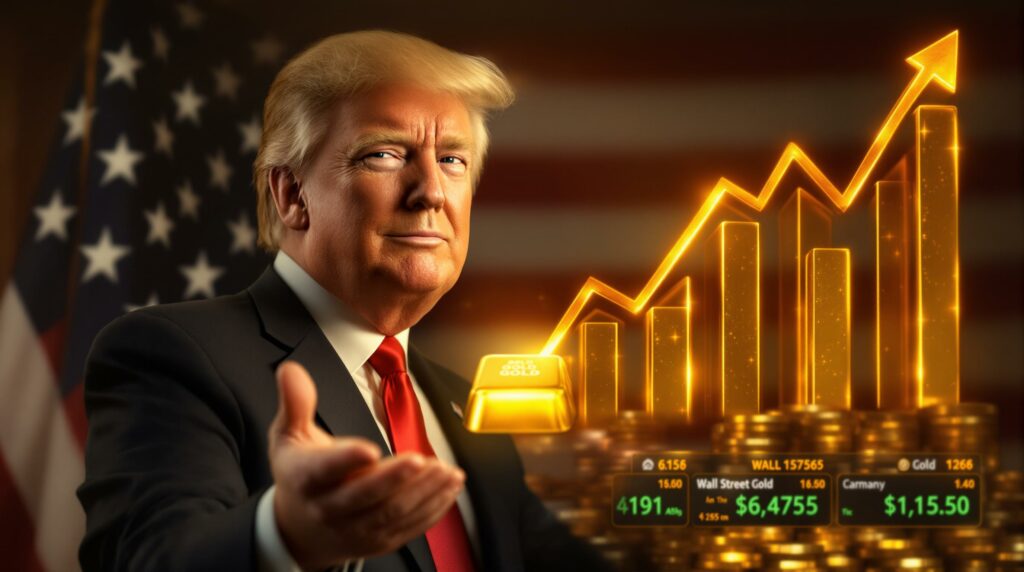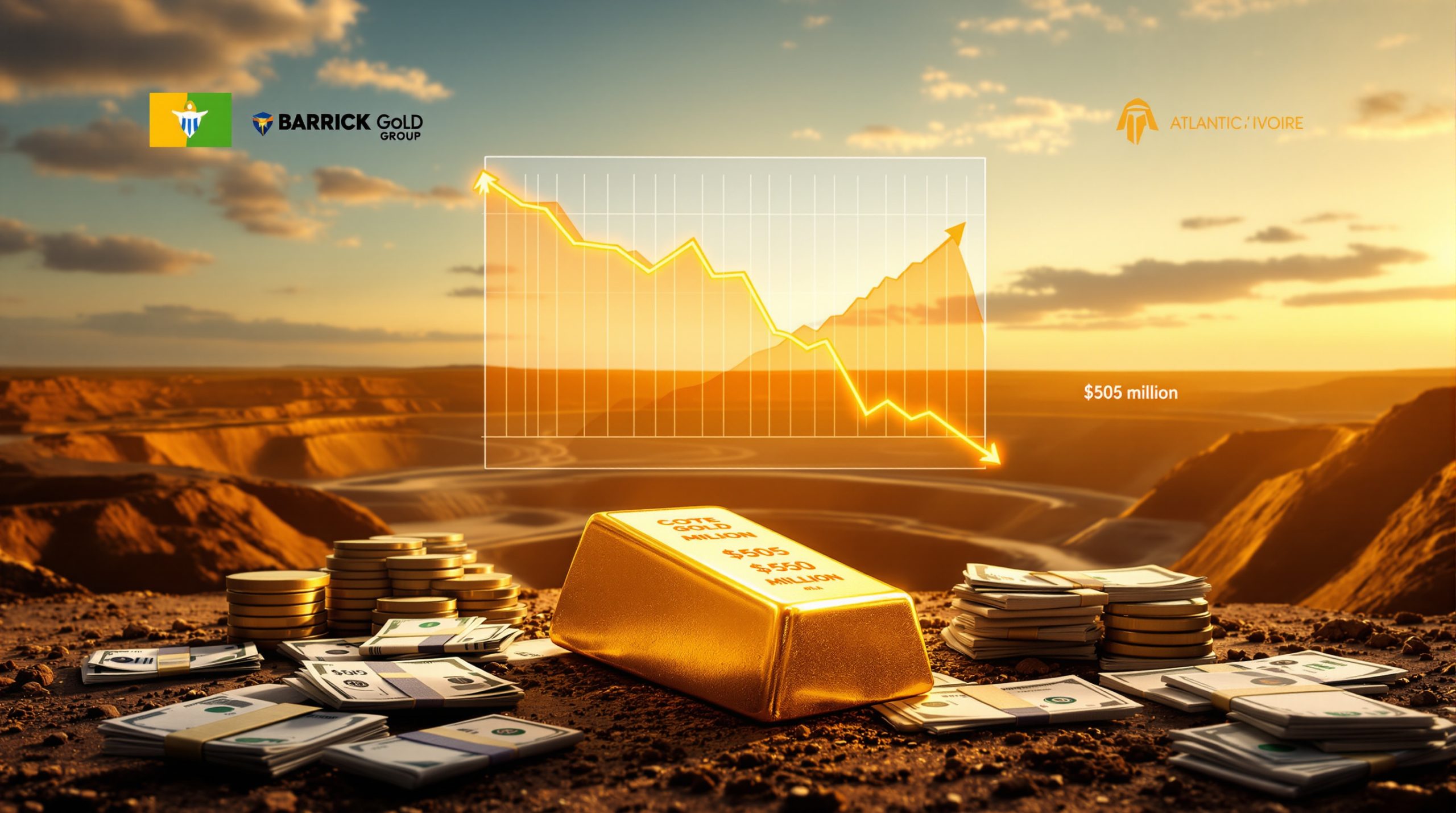Understanding Trump's Gold Tariff Exemption: Market Implications and Investment Outlook
In a significant policy announcement that has caught the attention of precious metals investors worldwide, President Trump recently declared that gold will be exempt from his proposed tariff structure. This declaration represents a notable carve-out in his otherwise comprehensive tariff strategy and has sparked considerable discussion about the implications for gold markets, investors, and the broader economy.
What Did President Trump Announce About Gold Tariffs?
Trump's Recent Statement on Gold Tariff Exemption
On August 11, 2025, President Trump made a clear declaration that gold would not be subject to tariffs under his proposed trade policy framework. This announcement, reported by CNBC's Eamon Javers on 'The Exchange,' marks a significant policy clarification amid broader discussions about international trade restrictions.
The exemption specifically targets physical gold, creating a distinctive status for the precious metal within Trump's economic approach. While the complete details of the policy implementation remain forthcoming, the declaration itself signals gold's unique position in the administration's view of strategic assets.
Context of the Broader Tariff Framework
Trump's proposed tariff plan includes substantial levies on a wide range of imported goods from various countries, designed to reshape America's trade relationships and boost domestic production. Within this comprehensive approach, the gold exemption stands out as a deliberate policy choice.
This carve-out for gold raises questions about the administration's underlying economic philosophy and the specific role gold plays in Trump's vision for American economic strength. The distinction between gold and other commodities suggests a recognition of gold's historical significance beyond its industrial applications.
Key Context: While most imported goods face potential tariff increases under Trump's plan, gold has been explicitly excluded, highlighting its special status in the administration's economic framework.
Why Is Gold Being Exempted From Tariffs?
Gold's Strategic Importance in Trump's Economic Vision
The exemption of gold from tariffs reflects its long-standing role as a traditional store of value. Throughout history, gold has served as a monetary anchor and inflation hedge during periods of economic uncertainty—qualities that align with certain aspects of Trump's economic philosophy.
By exempting gold, Trump appears to be acknowledging its status as a strategic asset rather than treating it as a typical commodity. This perspective connects to historical monetary policies and reflects gold's continuing relevance in modern financial systems despite the long abandonment of the gold standard.
Gold's exemption may also reflect a pragmatic recognition of its role in portfolio diversification for American investors seeking protection against currency devaluation and inflationary pressures.
Economic and Political Considerations
Several practical factors may have influenced the decision to exempt gold from tariffs:
- Investor constituency concerns: Tariffing gold could potentially alienate key financial supporters and traditional conservative voters who favor sound money principles
- Market disruption avoidance: Imposing tariffs on gold could create significant disruptions in financial markets where gold serves as a risk management tool
- Strategic positioning: Maintaining gold's accessibility preserves its function as a hedge against geopolitical instability
- Domestic mining interests: Supporting American gold mining operations aligns with broader economic nationalism goals
The exemption strikes a balance between protectionist trade policies and recognition of gold's unique position in the global financial system. It may also appeal to voters concerned about economic stability and traditional monetary values.
How Are Gold Markets Responding to Trump's Announcement?
Immediate Market Reaction
Following the announcement that gold would be exempt from tariffs, market participants have been recalibrating their expectations for the precious metal. While comprehensive price data requires additional time to fully reflect market sentiment, initial reactions suggest investors are processing the implications of this policy clarification.
The exemption removes a potential source of price uncertainty that had been weighing on gold markets. With this clarity, investors can now focus on fundamental factors driving all-time high gold prices, including inflation expectations, central bank policies, and geopolitical risks.
Trading volumes in gold futures and ETFs will be closely monitored in the coming days as institutional investors adjust their positioning based on this new information. The announcement may also influence decisions about physical gold allocation within investment portfolios.
Impact on Gold Mining Stocks
As noted by Barrick Mining's CEO in a recent CNBC interview, there remains "still more upside risk on gold prices" even before considering the potential impact of the tariff exemption. This perspective from one of the industry's largest producers suggests confidence in gold's fundamentals beyond just policy decisions.
Gold mining companies face a complex set of considerations following this announcement:
- Operational outlook: Stable or improved demand for physical gold could support mining company revenues
- Production economics: Changing price expectations may influence decisions about mine development and output levels
- Competitive landscape: Relative advantages for different producers based on their geographical footprint and cost structures
- Investment attractiveness: Mining equities may see changing investor interest as undervalued gold stocks are reassessed
Market capitalization changes across the gold mining sector will provide insights into how investors are integrating this policy development into their valuation models for producers.
What Does This Mean for Gold Investors?
Investment Implications for Physical Gold Holdings
The tariff exemption removes what could have been a significant cost barrier for physical gold investors. This policy clarity allows both retail and institutional investors to maintain existing allocation strategies without concerns about potential tariff-related price distortions.
For physical gold investors, several considerations now come into focus:
- Storage economics: The exemption preserves the current cost structure for vaulting and securing physical gold holdings
- International arbitrage: Price differentials between U.S. and international gold markets should remain consistent with historical patterns
- Premium structures: Retail products like coins and small bars should maintain their typical premium relationships to spot prices
- Liquidity expectations: The secondary market for physical gold should continue functioning without tariff-related complications
Investors with significant physical gold holdings may view the exemption as validation of gold's special status within the financial system and a positive signal for long-term ownership.
Gold ETFs and Investment Vehicles
Gold-backed ETFs represent a major channel for investment flows into the gold market, with billions of dollars in assets under management. The tariff exemption creates a more stable outlook for these investment vehicles, potentially influencing institutional allocations.
The policy clarification may affect several aspects of gold investment vehicle dynamics:
| Investment Vehicle | Potential Impact of Tariff Exemption |
|---|---|
| Physical Gold ETFs | Continued smooth creation/redemption process without tariff complications |
| Gold Mining ETFs | Potentially improved outlook based on stable demand environment |
| Gold Futures | Maintained alignment with physical market pricing |
| Gold Options | Possibly reduced volatility premium as one uncertainty factor is removed |
Institutional positioning in gold-related financial instruments will likely evolve as market participants integrate this policy development into their investment theses and risk models.
How Does This Fit Into Trump's Broader Economic Strategy?
Gold's Role in Trump's Economic Philosophy
The exemption of gold from tariffs aligns with Trump's previously expressed interest in gold as an economic foundation. Throughout his business and political career, Trump has occasionally referenced gold's historical importance and its role as a measure of economic stability.
This policy choice reflects a selective approach to economic nationalism—embracing protectionist measures broadly while recognizing certain strategic exceptions. The gold exemption suggests a nuanced view that distinguishes between different types of imports based on their economic function rather than simply their origin.
By maintaining gold's tariff-free status, Trump signals its special position within his economic worldview—a perspective that balances nationalist trade policies with recognition of gold's international character and monetary significance.
Potential Policy Evolution
The gold exemption may foreshadow additional policy clarifications regarding monetary metals and strategic commodities. Several questions remain open about the administration's approach:
- Will silver, platinum, and other precious metals receive similar exemptions?
- Does this signal a broader interest in monetary policy reforms involving gold?
- How might this exemption influence international negotiations on trade agreements?
- Could this be part of a larger strategy regarding currency policy and dollar strength?
The announcement potentially opens the door to further economic policy developments that differentiate between various categories of imports based on their strategic importance rather than treating all foreign goods uniformly.
What Are Industry Experts Saying About the Gold Tariff Exemption?
Mining Industry Perspectives
Leading mining executives have begun weighing in on the implications of the tariff exemption for their operations and the broader gold market surge. As noted in a recent CNBC interview, Barrick Mining's CEO expressed optimism about gold's price outlook even before considering the potential positive impact of the exemption.
Industry analysts are highlighting several potential operational benefits for mining companies:
- Demand stability: Removing tariff uncertainty helps maintain consistent market conditions for producers
- Investment planning: Clearer policy outlook supports long-term capital allocation decisions
- Cost structure predictability: Supply chain planning becomes more straightforward without tariff complications
- Market access: Continued seamless access to the crucial U.S. market for international producers
Production forecasts may be adjusted in the coming weeks as companies integrate this policy development into their operational planning and investor communications.
Financial Analyst Viewpoints
Wall Street perspectives on the gold exemption vary across investment firms, with analysts evaluating its significance within the broader economic and monetary landscape. The exemption adds another variable to already complex gold price models that incorporate inflation expectations, interest rate forecasts, and currency dynamics.
Some analysts view the exemption as fundamentally bullish for gold, removing a potential headwind and signaling gold's special status. Others maintain that broader economic factors—including Federal Reserve policy, real interest rates, and global growth outlook—remain the dominant drivers of gold price forecast regardless of tariff status.
Analytical Perspective: The tariff exemption represents an important policy clarification, but gold's price trajectory will still be primarily determined by macroeconomic conditions, central bank policies, and global risk sentiment.
How Might This Impact International Gold Markets?
Global Trade Implications
International gold trading dynamics may shift in response to U.S. tariff policies, with potential ripple effects across the global precious metals ecosystem. The U.S. represents a significant market for gold, and maintaining its tariff-free status preserves established trading patterns.
Major gold-producing nations—including China, Russia, Australia, and Canada—face a changing competitive landscape under Trump's broader tariff framework, but the gold exemption maintains the status quo for this specific commodity. This differential treatment could influence how these countries position their overall trade negotiations with the U.S.
Cross-border gold flows could be influenced by the U.S. exemption policy, particularly if other countries respond with their own policy adjustments regarding precious metals. The international gold market has historically functioned with relatively few trade barriers, and maintaining this openness in the U.S. helps preserve global market efficiency.
Central Bank Considerations
Central banks collectively hold over 35,000 tonnes of gold in their reserves, making them significant stakeholders in the global gold market. The tariff exemption maintains their ability to manage these reserves without additional policy complications when dealing with U.S. markets.
International reserve managers may reassess gold investment strategies in light of evolving U.S. policies, considering:
- Reserve diversification: Gold's role in reducing dependence on any single currency
- Geopolitical hedging: Protection against sanctions or other financial restrictions
- Long-term value preservation: Maintaining purchasing power across economic cycles
- Crisis preparation: Building resilience against potential financial system disruptions
Geopolitical implications emerge for nations with significant gold reserves, as the metal's special status in U.S. trade policy may reinforce its role as a strategic asset beyond just its market value.
What Questions Remain About Gold's Tariff Status?
Policy Implementation Details
While the principle of gold's exemption has been established, specific mechanisms for verifying and implementing this status remain unclear. Market participants will need additional guidance on several practical matters:
- Product classification: How will different gold products be classified for customs purposes?
- Purity thresholds: Will the exemption apply only to certain fineness standards?
- Form distinctions: How will the policy treat coins, bars, jewelry, and industrial gold differently?
- Country-of-origin requirements: Will gold processed or refined in certain countries face different treatment?
Customs authorities will need clear guidelines to consistently apply the exemption across the diverse range of gold products entering the U.S. market. Industry stakeholders await formal clarification of these operational details.
Potential Timeline and Implementation
The effective date and implementation process for the exemption require clarification from relevant government agencies. Transitional provisions may be necessary to address goods already in transit or in customs processing at the time the policy takes effect.
Regulatory frameworks for enforcing the gold exemption are still developing, with several government departments potentially involved in establishing the practical mechanics. The Treasury Department, Customs and Border Protection, and the U.S. Trade Representative's office may all play roles in translating the policy announcement into operational procedures.
Industry participants throughout the gold supply chain—from miners to refiners, wholesalers, and retailers—await formal guidance to ensure compliance with the new framework while minimizing disruption to established business practices.
FAQ: Trump's Gold Tariff Exemption
Will this exemption apply to all forms of gold?
The announcement suggests the exemption will apply to physical gold, but specific details about different forms (jewelry, coins, industrial gold) remain to be clarified through official policy documentation. Market participants anticipate that pure investment gold (bars and coins of recognized purity standards) will certainly be covered, while treatment of other forms may depend on specific regulatory determinations.
How does this affect gold mining companies?
Gold mining companies may benefit from stable or improved demand for their products, as the exemption removes a potential barrier to gold purchases. This could potentially support their operational outlook and profitability. Mining executives, including Barrick's CEO, have expressed optimism about gold's price outlook, which could be further supported by this policy clarification.
Does this exemption extend to other precious metals?
Currently, the announcement specifically mentions gold. There has been no confirmation about whether silver, platinum, or other precious metals will receive similar exemptions from tariffs. This distinction creates an interesting divergence in policy treatment across the precious metals complex that investors and industry participants will need to monitor.
How might this impact gold prices long-term?
While immediate market reactions have occurred, long-term price implications depend on multiple factors including broader economic policies, inflation trends, and global demand patterns beyond just the tariff exemption. The removal of tariff uncertainty eliminates one potential headwind, but fundamental drivers—including real interest rates, inflation expectations, and central bank policies—will likely remain the primary determinants of gold's price trajectory.
How does this compare to historical U.S. policies on gold?
This exemption represents a distinctive approach compared to previous administrations, potentially signaling a shift in how gold is viewed within the broader U.S. economic and trade framework. While gold has generally moved freely in international trade since the end of the Bretton Woods system, this explicit exemption within an otherwise protectionist framework highlights gold's special status in the current administration's economic thinking.
Further Exploration:
Readers interested in learning more about gold market dynamics and trade policies can also explore related educational content on The Wall Street Journal, which offers additional market analysis and expert perspectives on precious metals and economic policy.
Looking to Catch The Next Major ASX Mining Discovery?
Discovery Alert's proprietary Discovery IQ model instantly identifies significant ASX mineral discoveries, turning complex data into actionable investment insights before the broader market reacts. Understand why major discoveries like De Grey Mining led to exceptional returns by exploring the dedicated discoveries page.




